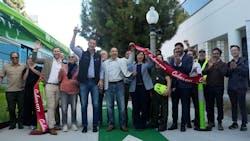Culver City completes Robertson Bus/Bike Lane Project
Culver City has completed the Robertson Bus/Bike Lane Project, an improvement designed to enhance access around the Culver City E Line Station for cyclists, pedestrians and transit users.
The project delivers several improvements along Robertson Boulevard between Washington Boulevard and Venice Boulevard, funded via the Metro Active Transportation Program, including:
- Protected bike lanes that improve cyclist safety and connectivity.
- Five dedicated bus layover bays serving Culver CityBus, Big Blue Bus, and the Los Angeles County Metropolitan Transportation Authority (L.A. Metro).
- A widened sidewalk on the east side of Robertson Boulevard to improve pedestrian comfort and accessibility.
- Removal of a right-turn slip lane at Robertson and Washington boulevards to reduce vehicle-pedestrian conflict points.
- Installation of stormwater treatment basins to improve water quality.
- Planting new trees to enhance the streetscape and provide shade.
“These are grant dollars at work, improving safety for people who like to bike and walk in between our downtown and art district, especially with accessing the Metro line at Ivy Station and Platform,” said Culver City Mayor Dan O’Brien. “This connectivity continues our commitment to providing safe transportation access for everyone.”
The city says the Robertson Bus/Bike Lane Project underscores its ongoing commitment to sustainable transportation and climate action, noting that the project aligns with broader regional efforts to expand transit offerings for area residents and commuters.
Culver City also notes it continues to support L.A. Metro’s Sepulveda Transit Corridor Project, a proposed high-capacity rail line that would connect the Westside to the San Fernando Valley. The Culver City Council voted earlier this year to support Alternatives 4 and 5, both heavy rail subway concepts for the project that could provide 20-minute travel times between the two areas.
If approved by L.A. Metro next year, the Sepulveda Transit Corridor Project could reduce congestion along the 405 Freeway.
“These alternatives supported by the Culver City City Council offer the highest ridership and lowest transit times that could result in an economic boon for Culver City,” O’Brien said. “While it’s a long journey ahead, it’s important we this process begin now. We’re proud to once again be the first to support this transformative public transportation project.”
